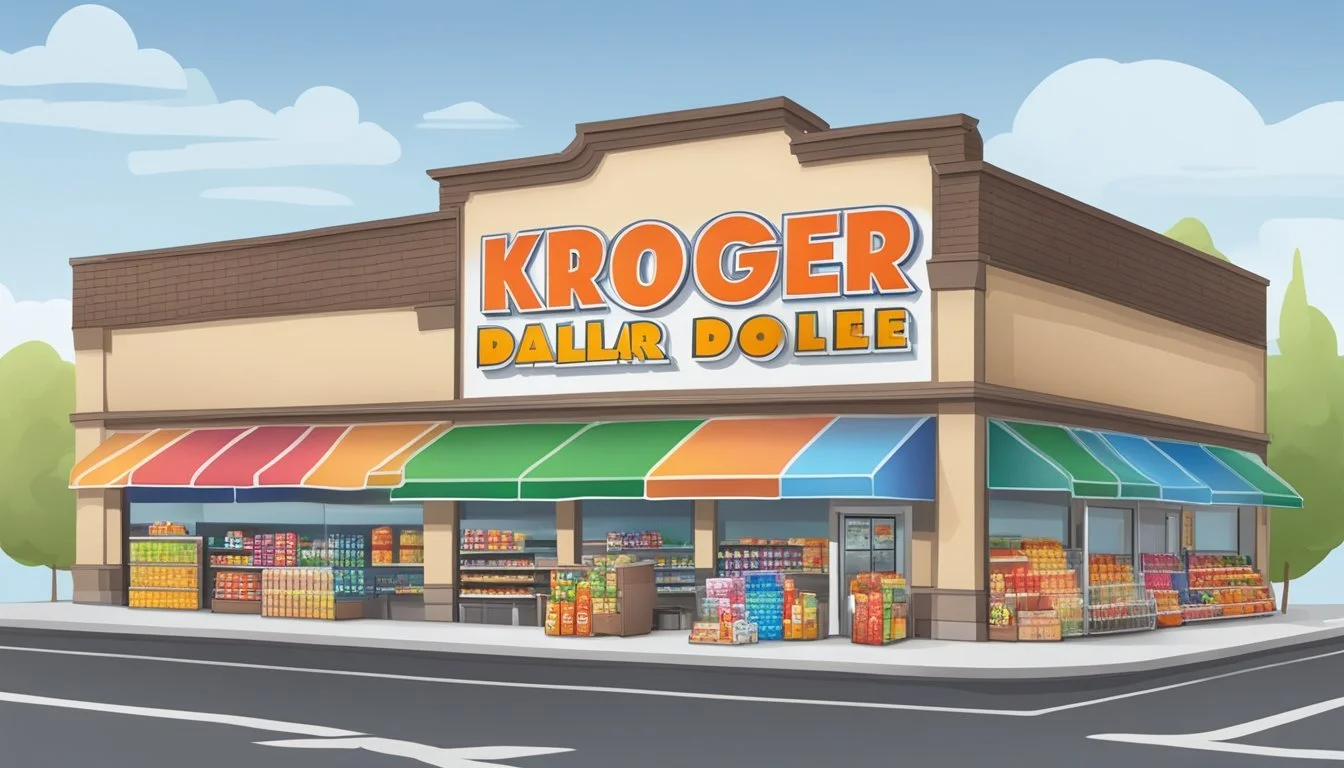Is Family Dollar Cheaper Than Kroger?
A Price Comparison Analysis
Family Dollar and Kroger are two popular retail chains that cater to budget-conscious shoppers. Many consumers wonder which store offers the best value for their money when it comes to groceries and household items.
While Family Dollar often has lower prices on certain packaged goods and household items, Kroger generally provides better overall value for groceries. Kroger's regular sales, wider product selection, and loyalty program can lead to significant savings for shoppers. However, the price differences between the two stores can vary depending on specific items and locations.
Savvy shoppers may find that strategically purchasing from both stores yields the best results. Family Dollar's strengths lie in discounted non-perishable goods and basic household supplies, while Kroger excels in fresh produce, meats, and a more extensive grocery selection. Comparing prices and taking advantage of each store's unique offerings can help consumers maximize their savings.
Understanding Grocery Retailers
Grocery retailers encompass a diverse range of stores, from discount chains to full-service supermarkets. These businesses cater to different consumer needs and preferences, offering varied product selections and pricing strategies.
Difference Between Discount and Grocery Stores
Discount stores like Family Dollar focus on offering low prices on a limited selection of items. They typically stock non-perishable goods, household products, and some basic groceries.
Grocery stores such as Kroger provide a wider range of products, including fresh produce, meats, and bakery items. These retailers often have larger stores and offer more brands and specialty products.
Discount stores prioritize cost savings, while grocery stores emphasize variety and quality. This difference in focus affects their pricing strategies and target customers.
Retailers' Expansion and History
Family Dollar began as a single store in Charlotte, North Carolina in 1959. It rapidly expanded across the United States, targeting low to middle-income neighborhoods.
Kroger's history dates back to 1883 when Barney Kroger opened his first grocery store in Cincinnati, Ohio. The company grew through acquisitions and new store openings.
Both retailers have expanded their presence nationwide. Family Dollar now operates over 8,000 stores in 46 states. Kroger manages nearly 2,800 stores under various banners across 35 states.
These expansions reflect changing consumer demands and shopping habits in the United States over the past century.
Price Determinants in Retail
Retail pricing is influenced by various factors that shape the competitive landscape and consumer behavior. These determinants play a crucial role in how retailers like Family Dollar and Kroger set their prices.
The Role of Location in Pricing
Location significantly impacts retail pricing strategies. Urban stores often face higher operational costs, leading to slightly elevated prices. Suburban locations may offer more competitive pricing due to lower overhead. Rural areas might see higher prices due to transportation costs and limited competition.
Proximity to competitors also affects pricing. When multiple retailers cluster in an area, it often results in more competitive pricing. Demographic factors of the surrounding area, such as average income and consumer preferences, influence pricing decisions.
Retailers analyze these location-based factors to determine optimal pricing for each store, balancing profitability with market competitiveness.
Inflation and the Consumer Price Index
Inflation directly affects retail pricing. As the cost of goods and services rises, retailers often adjust their prices to maintain profit margins. The Consumer Price Index (CPI), calculated by the Bureau of Labor Statistics, measures these price changes over time.
Retailers closely monitor the CPI to inform their pricing strategies. When inflation rises, consumers may see price increases across various product categories. Some retailers might absorb part of the cost increase to remain competitive, while others may pass it on to consumers.
During periods of high inflation, budget-conscious shoppers often seek out discount retailers like Family Dollar for better value.
Private Labels vs. National Brands
Private-label brands, also known as store brands, play a significant role in retail pricing. These products are typically priced lower than national brands, offering consumers a more affordable option.
Retailers like Kroger invest heavily in developing their private-label products to compete with national brands on quality while maintaining a price advantage. This strategy allows them to offer competitive prices and potentially higher profit margins.
National brands often command premium prices due to brand recognition and marketing efforts. However, they may offer promotions or discounts to compete with private labels and maintain market share.
The mix of private labels and national brands in a retailer's inventory significantly influences overall pricing strategy and perceived value.
Sales, Discounts, and Loyalty Programs
Retailers use various promotional tactics to attract customers and drive sales. Temporary price reductions, buy-one-get-one-free offers, and seasonal sales are common strategies to create perceived value and increase foot traffic.
Loyalty programs reward repeat customers with exclusive discounts, personalized offers, and points systems. These programs aim to foster customer retention and encourage higher spending over time.
Digital coupons have become increasingly popular, allowing retailers to offer targeted discounts based on consumer behavior and purchasing history. This approach enables more precise pricing strategies and can lead to increased sales volume.
Retailers carefully balance these promotional activities with regular pricing to maintain profitability while remaining competitive in the market.
Comparing Family Dollar and Kroger
Family Dollar and Kroger offer distinct shopping experiences with varying price points and product selections. Their differences impact grocery bills and available options for consumers.
Price Benchmarking for Common Items
Family Dollar often provides lower prices on packaged goods and household items. A box of cereal at Family Dollar may cost $2.50, while the same brand at Kroger could be $3.25. Cleaning supplies like laundry detergent typically sell for 10-15% less at Family Dollar.
Kroger, however, frequently offers competitive prices on fresh produce and meats. A pound of bananas might be $0.59 at Kroger versus $0.79 at Family Dollar. Kroger's store-brand items also tend to be cheaper than name brands found at Family Dollar.
Both stores run regular sales, but Kroger's wider selection allows for more diverse discounts. Family Dollar focuses on everyday low prices rather than frequent promotions.
Grocery Bills: Comparing Total Costs
A typical grocery basket at Family Dollar costs less for basic necessities and non-perishables. A cart with pasta, canned goods, snacks, and toiletries might total $45 at Family Dollar compared to $55 at Kroger.
For a full weekly shopping trip including fresh produce, dairy, and meats, Kroger often proves more economical. A family of four could spend $120 at Kroger for a week's groceries, while the same items might cost $140 at Family Dollar due to higher prices on perishables.
Kroger's loyalty program can significantly reduce costs for regular shoppers. Members save an average of 5-10% on their total bill through personalized coupons and fuel points.
Selection and Variety of Products
Family Dollar offers a limited selection focused on essential items. Their stores typically stock around 1,000-2,000 products across food, cleaning supplies, and basic household goods.
Kroger provides a much wider range with 30,000-50,000 items in a typical store. This includes extensive fresh produce sections, bakeries, delis, and specialized departments like organic foods and international cuisine.
Family Dollar's food selection emphasizes non-perishables and frozen items. Fresh produce is limited to basics like potatoes and onions. Kroger offers a full range of fresh fruits, vegetables, meats, and dairy products.
Kroger also carries a broader selection of national brands alongside their own private label options. Family Dollar focuses more on budget brands and their own product lines.
Strategies for Savings
Effective strategies can help shoppers maximize savings at both Family Dollar and Kroger. Smart techniques and leveraging rewards programs allow customers to stretch their budgets further.
Maximizing Rewards Programs
Kroger offers a robust loyalty program called Kroger Plus. Members earn fuel points and receive personalized digital coupons. The app provides easy access to weekly ads and exclusive savings. Family Dollar's Smart Coupons program allows customers to clip digital coupons for instant savings at checkout. Both stores frequently offer bonus points or extra discounts for specific product purchases.
Signing up for email newsletters from both retailers can provide advance notice of sales and special promotions. Some Kroger locations offer double or triple coupon days, multiplying savings on manufacturer coupons.
Smart Shopping Techniques
Creating a shopping list before visiting either store helps avoid impulse purchases. Comparing unit prices rather than total cost can reveal better deals on larger sizes. Both Family Dollar and Kroger offer store-brand alternatives that are often cheaper than name brands.
Timing purchases around sales cycles can lead to significant savings. Kroger typically runs a 10 for $10 promotion on select items. Family Dollar often has $1 deals on various products. Checking clearance sections in both stores can uncover marked-down items.
Using cash-back apps like Ibotta or Fetch Rewards provides additional savings on grocery purchases at both retailers. These apps offer rebates on specific products or entire shopping trips.
Assessing Alternatives to Family Dollar and Kroger
Several retailers offer competitive pricing and product selections for budget-conscious shoppers. These options range from discount stores to national supermarket chains, each with unique strengths and offerings.
Considering Other Discount Stores
Walmart stands out as a formidable alternative to Family Dollar and Kroger. The retail giant offers a wide range of products at competitive prices, often beating dollar stores in the food category by 6.6%.
Dollar General is another strong contender, though a Bank of America study found its food prices rose faster than Walmart's. Aldi provides a no-frills shopping experience with low prices on many items.
Target positions itself as a more upscale discount retailer, offering a mix of groceries and household goods. Many shoppers appreciate its store designs and exclusive brands.
Exploring National Grocery Chains
Publix, known for its customer service, competes with Kroger in certain regions. While prices may be higher, frequent sales and a popular store-brand line offer value.
Meijer, a Midwest-based superstore chain, combines groceries with general merchandise in a one-stop shop format. Their large stores often feature competitive pricing on a wide range of products.
WinCo Foods, a employee-owned company, offers low prices on bulk items and produce. Their no-frills approach and limited locations contribute to cost savings passed on to customers.
Costco provides bulk buying options and high-quality store brands. While requiring a membership, their pricing can be advantageous for larger households or those able to store bulk quantities.
Product-Specific Price Analysis
Family Dollar and Kroger offer different pricing strategies across various product categories. A closer look at specific items reveals notable differences in cost and selection between the two retailers.
Examining Meat and Produce Prices
Family Dollar's meat selection is limited, focusing on frozen and processed options. Kroger provides a wider range of fresh meats at competitive prices. For produce, Kroger generally offers better quality and variety. Family Dollar stocks some fruits and vegetables, but the selection is smaller.
Kroger's locally sourced produce often comes at a premium. Family Dollar rarely carries local produce. In the seafood category, Kroger has a clear advantage with fresh and frozen options. Family Dollar typically only stocks canned seafood items.
Analysis of Pantry and Frozen Items
Family Dollar excels in pantry staples. Rice, pasta, and canned goods are often priced lower than at Kroger. Family Dollar's private label brands contribute to these savings. Kroger's selection is more extensive, including premium brands.
Frozen foods show mixed results. Family Dollar offers competitive prices on basic frozen meals and vegetables. Kroger's frozen section is more diverse, with both budget and premium options. Bakery items are limited at Family Dollar, while Kroger provides fresh-baked goods.
Dairy products are generally cheaper at Family Dollar, but Kroger offers a wider range. For beverages and condiments, Family Dollar often has lower prices on name-brand items. Kroger's store-brand alternatives can sometimes match or beat these prices.
Impact on Consumer Shopping Behavior
Price differences between Family Dollar and Kroger significantly influence how consumers shop for groceries and household essentials. These pricing strategies shape customer loyalty and purchasing habits.
Customer Service and Shopping Experience
Family Dollar focuses on a no-frills shopping environment, prioritizing low prices over extensive customer service. Stores are typically smaller, with a limited selection of products. This appeals to shoppers seeking quick purchases of basic items.
Kroger offers a more traditional supermarket experience. Larger stores provide a wider product range and often include pharmacies, delis, and bakeries. Customer service is generally more comprehensive, with staff available to assist shoppers.
The shopping atmosphere impacts consumer behavior. Family Dollar attracts price-conscious customers who prioritize savings over ambiance. Kroger appeals to those who value a full-service grocery experience, even if it means paying slightly higher prices.
Consumer Response to Pricing Strategies
Family Dollar's everyday low pricing model attracts budget-conscious shoppers. Consumers often visit these stores for specific low-cost items or to stock up on household basics. This strategy drives frequent, targeted purchases.
Kroger employs a mix of regular prices and promotions. Their loyalty program offers personalized discounts, encouraging repeat visits. Shoppers may plan trips around sales or use digital coupons to maximize savings.
Price-sensitive consumers may split their shopping between both retailers. They might purchase non-perishables at Family Dollar while getting fresh produce and specialty items at Kroger. This behavior reflects a growing trend of consumers actively seeking the best deals across multiple stores to manage their grocery bills.
Final Considerations
Shoppers must weigh multiple factors when deciding between Family Dollar and Kroger for their grocery needs. Price is just one aspect of the overall shopping experience.
The Balance of Cost and Convenience
Location plays a crucial role in store choice. Family Dollar often has more urban locations, while Kroger tends to have larger stores in suburban areas. This impacts travel time and fuel costs for consumers.
Store hours differ between the two chains. Family Dollar typically has shorter operating hours compared to many Kroger locations that offer extended or even 24-hour service.
Selection varies significantly. Kroger provides a wider range of products, including fresh produce and meats. Family Dollar focuses on packaged goods and household items.
For a complete shopping list, Kroger is likely to have everything needed. Family Dollar may require additional stops for certain groceries.
Consumer decisions should account for household budget constraints. While Family Dollar offers lower prices on some items, Kroger's sales and loyalty program can provide substantial savings for regular shoppers.




